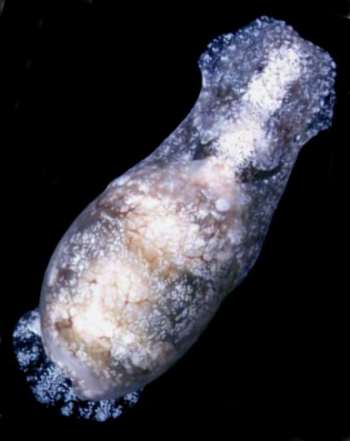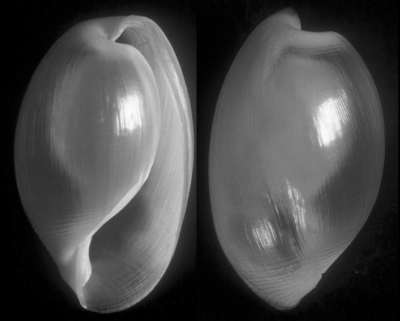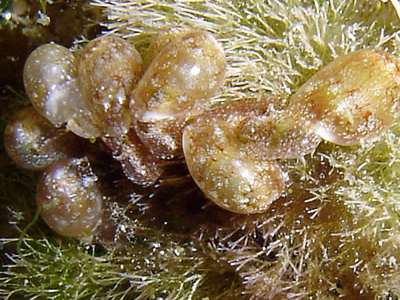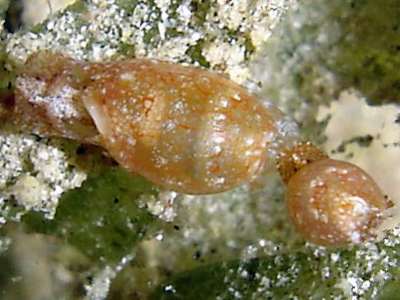

Diniatys dubia
(Schepman, 1913)
Order: CEPHALASPIDEA
Family: Haminoeidae
PHOTO
Upper: Guam, Cocos-Sand Is., 1 m; Length 12.7 mm; 16 October 1971. C.100. Lower:Shell 7.4 x 4.5. Guam, Bile Bay, 17 m. 18 July 1998; C.100. Photos: Clay Carlson & Patty Jo Hoff
Most of the cephalaspidean bubble shells were described solely from their empty shells. Often we need to know their anatomy before they can be condifidently placed in genera, and sometimes families. Clay Carlson & Patty Jo Hoff have been investigating the diverse fauna found in Guam, ad this identification is based on their studies.
"The nature of the gizzard plates - single rows of rods; as well as the downward extension of the columella - suggest this haminoeid belongs in this genus" ... Clay Carlson & Patty Jo Hoff
-
Schepman, M.M. (1913). The Prosobranchia, Pulmonata and Opisthobranchia Tectibranchiata, Tribe Bullomorpha, of the Siboga Expedition. Monograph 49. .
Rudman, W.B., 2005 (October 12) Diniatys dubia (Schepman, 1913). [In] Sea Slug Forum. Australian Museum, Sydney. Available from http://www.seaslugforum.net/find/dinidubi
Related messages
Re: Diniatys dubia from the Red Sea
October 19, 2005
From: Binyamin Koretz

Hi Bill,
Thanks to you and Drs Carlson and Hoff for the ID of the little Haminoeid as Diniatys dubia. During the course of the summer we started seeing them pair up so I suspected they were mature specimens. But now they're so plentiful it's possible to see mating chains like the spectacular one in the attached photo.
Locality: Eilat, Satil Area, Israel. Red Sea (Gulf of Eilat). Depth: 21 m. Length: 5 to 7 mm 15 October 2005. grassy expanse (with occasional small corals) at foot of slope. Photographer: Shulamit Koretz
In recent weeks this one dive site has been simply 'bubbling' with haminoeids - Atys semistriata, Haminoea cyanomarginata, Liloa curta, and of course Diniatys dubia, and frequently in twos and threes. And I would mention that this same site was ground zero for sea hare activity in the spring and summer (March-July) - big fat Dolabella auricularia, Aplysia parvula, Petalifera ramosa, Notarchus indicus, and even Stylocheilus striatus. Not to mention a large number of dorid nudibranch species, and all this in no more than a couple of thousand square meters of sea grass and small coral heads.
Best regards
Binyamin
binyamin@koretz.net
Koretz, B., 2005 (Oct 19) Re: Diniatys dubia from the Red Sea. [Message in] Sea Slug Forum. Australian Museum, Sydney. Available from http://www.seaslugforum.net/find/15041
Dear Binyamin,
It sounds a most exciting place
Best wishes,
Bill Rudman
Diniatys dubia from Guam
October 13, 2005
From: C.Carlson & P-J.Hoff

Dear Bill,
Here is the animal, Diniatys dubia (Schepman, 1913), which produced the egg mass, being eaten by the dorid in my accompanying message [#14989 ] .
Locality: Guam, Cocos-Sand Is., 1 m; Length 12.7 mm; 16 October 1971. C.100. Photo:
Clay Carlson & Patty Jo Hoff
ccarlson@guam.net
Carlson, C. & Hoff, PJ, 2005 (Oct 13) Diniatys dubia from Guam. [Message in] Sea Slug Forum. Australian Museum, Sydney. Available from http://www.seaslugforum.net/find/14999Thanks Clay & Patty Jo,
The mucus-eating dorid is an interesting story
Best wishes,
Bill Rudman
Re: Juvenile Bulla from the Red Sea
October 13, 2005
From: C.Carlson & P-J.Hoff

Bill,
Binyamin's animal [message #14434] is not juvenile Bulla. It is the beast we are calling Diniatys dubia (Schepman 1913). I sent you a scan of a slightly darker form earlier [#14999 ]. I have added a shell graphic to go with this message.
Photo: Diniatys dubia (Schepman, 1913) shell 7.4 x 4.5. Guam, Bile Bay, 17 m. 18 July 1998; C.100. Photo: Clay Carlson & Patty Jo Hoff
The nature of the gizzard plates - single rows of rods; as well as the downward extension of the columella - suggest this placement.
Clay Carlson & Patty Jo Hoff
ccarlson@guam.net
Carlson, C. & Hoff, PJ, 2005 (Oct 13) Re: Juvenile Bulla from the Red Sea. [Message in] Sea Slug Forum. Australian Museum, Sydney. Available from http://www.seaslugforum.net/find/15003Dear Clay & Patty Jo,
I should have looked more closely at the head. As you can see in Lindsay Warren's message [#4449] the front corners of the head in Bulla are drawn out, almost inot siphons. Thanks for picking this up so quickly.
Best wishes,
Bill Rudman
Juvenile Bulla from the Red Sea
October 12, 2005
From: Binyamin Koretz

Dear Bill,
My wife Shulamit found and photographed these small bubble shells on a recent night dive. Structurally they seem to bear resemblance to the other unclassified haminoeid spp on the Forum.
Locality: Eilat, Satil Area. Israel. Red Sea (Gulf of Eilat). Depth: 23 m. Length: up to 7 mm. 23 July 2005. sea grass and patch reef. Photographer: Shulamit Koretz
The 2 photos show a total of 3 different specimens.
Best regards
Binyamin
binyamin@koretz.net
Koretz, B., 2005 (Oct 12) Juvenile Bulla from the Red Sea. [Message in] Sea Slug Forum. Australian Museum, Sydney. Available from http://www.seaslugforum.net/find/14434
Note added 13 October 2005: This is Diniatys dubia. See message #15003.
Dear Binyamin,
I am pretty sure these are very juvenile Bulla ampulla. At this small size the shell is still quite transparent. You'll note the parapodial folds don't extend far down the shell. This is characteristic of Bulla. In most Haminoea species the parapodial folds enclose most of the shell even when they are small.
Best wishes,
Bill Rudman
